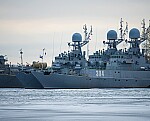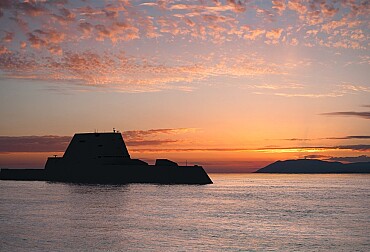A powerful Chinese Navy carrier group monitored by JMSDF near Okinawa
In recent years, it hasn't been uncommon to see Chinese aircraft carriers Liaoning or Shandong sailing through the Miyako Strait on its way to the western part of the Pacific Ocean. As this passage is located to the south-west of Okinawa, in Japan's exclusive economic zone (EEZ), such transits are closely monitored by the Japanese Maritime Self-Defence Forces (JMSDF).
Over the last two or three years, the Chinese navy carrier groups sent through this strait have become increasingly powerful, notably with the presence of Type 055 (Renhai class) destroyers, equipped with 112 vertical launch tubes. Until now, they have been careful not to venture too close to Japanese territorial waters. However, on September 17, the Japanese Ministry of Defense reported that the aircraft carrier Liaoning, along with the 052D destroyers Chengdu (no. 120) and Huainan (no. 123), had been spotted for the first time near Japan’s territorial waters, specifically between the islands of Yonaguni and Iriomote, in Okinawa Prefecture.

A contiguous zone is adjacent to territorial waters and extends up to 24 nautical miles (27.6 mi/44.4 km). The coastal country may exercise controls there to prevent or repress infringements of its laws. Yonaguni Island, Japan's westernmost island, lies around 93 miles (150 km) southwest of the Senkaku Islands—controlled by Tokyo but claimed by Beijing—and 62 miles (100 km) east of Taiwan.
While the size of the Chinese navy carrier group may seem modest by typical standards, its composition can vary depending on the mission. Generally, it includes ships for anti-submarine warfare and air defense, an attack submarine, and a refueling tanker. The two Type 052D destroyers accompanying the Liaoning are heavily armed vessels. With a displacement of 8,200 tons, each is equipped with 64 vertical launch cells for CJ-10, YJ-18A, and HQ-16 surface-to-air missiles, along with six torpedo tubes. They also feature a Type 364A active antenna radar (AESA), air surveillance radar, surface radar, hull sonar, and a low-frequency towed sonar.
Japan recently condemned the intrusion of a Chinese Y-9DZ intelligence aircraft into its airspace, as well as the violation of its territorial waters by a Shupang (Type 636) hydrographic vessel. In response to the passage of the Liaoning between Yonaguni and Iriomote islands, Hiroshi Moriya, a spokesperson for the Japanese government, described it as an "absolutely unacceptable incident":
“After the recent violation of airspace by a Chinese military aircraft and the movements of Chinese warships and other vessels around Japan, this incident is totally unacceptable from the point of view of national and regional security," he said. "We have expressed our serious concerns to China through diplomatic channels,” he added. The Chinese Ministry of Foreign Affairs dismissed Japan’s concerns, claiming that China’s activities complied with both Chinese and international law.
The Liaoning aircraft carrier
The Liaoning, which entered service with the Chinese navy on September 25, 2012, was originally developed and built in the Soviet Union in the 1980s and 1990s by the Nevskoye Planning and Design Bureau and the Chernomorski Sudostroitelny Zavod, and later by DSIC, Dalian Shipbuilding Industry Company. It is the second ship of Project 1143.5, a sister ship to the Russian aircraft carrier Admiral Kuznetsov. Construction began on December 6, 1985, in Nikolaev (now Mykolaiv), Ukraine, under the name Riga. Launched on November 25, 1988, the ship was renamed Varyag in 1990. Construction halted in 1992 following the dissolution of the USSR, with the ship approximately 70% complete. In April 1998, China purchased the vessel for $20 million, initially planning to convert it into a floating casino.
Between 2005 and 2008, DSIC conducted further work on the vessel, and in May 2010, Shenyang J-15 fighter jets made their first landings on the carrier. The Liaoning officially entered service on September 25, 2012. It is a STOBAR (Short Take-Off But Arrested Recovery) carrier capable of carrying 24 J-15 fighters, a Chinese version of the Russian Sukhoi Su-33. A typical carrier group includes the Liaoning, a Type 055 destroyer, two Type 052D destroyers, a Type 054A frigate, a submarine, and a Type 901 support ship.
The Shandong aircraft carrier
Developed in 2010 by the Nevskoye Planning and Design Bureau and built by DSIC (Dalian Shipbuilding Industry Company), the Shandong entered service on December 17, 2019. It is China’s second aircraft carrier and the first to be constructed domestically, based on the design of the Liaoning. Like the Liaoning, the Shandong is a STOBAR carrier and can carry 24 J-15 fighters. Its carrier group is typically composed similarly to that of the Liaoning.
The Type 055 destroyer
The Type 055 is the most powerful destroyer in the Chinese navy. These heavy guided missile destroyers weigh 13,200 tons and measure 590 feet (180 m) in length. With 112 missile launchers for five different types of missiles, the Type 055 can carry YJ-18 missiles capable of striking targets over 500 kilometers away, whether ships or land bases. For air defense, it carries HQ-9 missiles designed to destroy enemy aircraft. Additionally, the destroyer is capable of carrying Russian SA-17 Grizzly missiles. The Type 055 is a versatile ship, equipped to handle threats from the air, sea, or land, and can also deploy torpedoes and anti-submarine missiles to protect Chinese carriers from underwater threats.
The Japanese Maritime Self-Defence Force (JMSDF)
The Japanese Maritime Self-Defense Force is one of the most formidable and balanced naval forces in Asia. With the conversion of Izumo-class helicopter destroyers into light aircraft carriers, the acquisition of F-35B stealth fighter-bombers, a fleet of advanced escort ships, and a highly sophisticated submarine force, the JMSDF has set a standard in the region. Given the increasingly complex security environment and the Japanese government's commitment to bolstering defense spending, it is expected that the JMSDF will continue to grow in both size and capability in the coming years.
The JMSDF currently operates 154 ships, including around 50 destroyers. According to the Global Power Index 2021, the Japanese navy ranked fifth globally, behind the United States, Russia, China, and India. Its naval air force comprises 346 aircraft and helicopters. The force is organized into the Self-Defense Fleet, which includes combat forces, five maritime districts, an air training command, and a naval training squadron, along with other minor commands.








